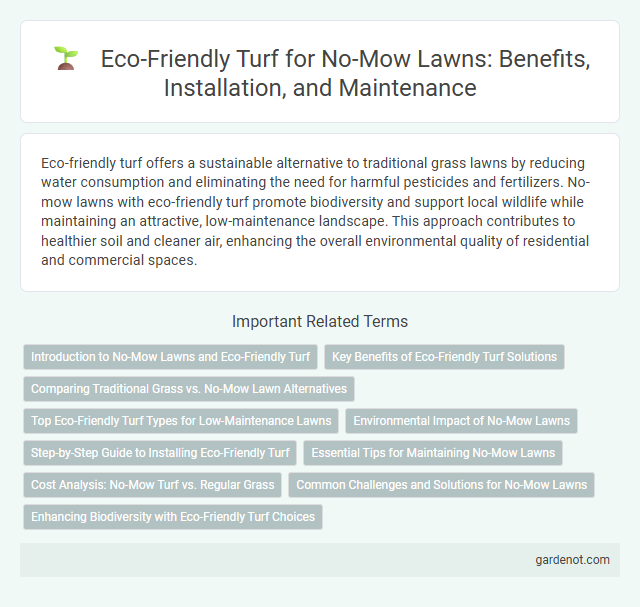Eco-friendly turf offers a sustainable alternative to traditional grass lawns by reducing water consumption and eliminating the need for harmful pesticides and fertilizers. No-mow lawns with eco-friendly turf promote biodiversity and support local wildlife while maintaining an attractive, low-maintenance landscape. This approach contributes to healthier soil and cleaner air, enhancing the overall environmental quality of residential and commercial spaces.
Introduction to No-Mow Lawns and Eco-Friendly Turf
No-mow lawns utilize eco-friendly turf varieties that reduce the need for frequent mowing, conserving water and decreasing carbon emissions from lawn equipment. These grasses, such as fine fescues and buffalo grass, thrive with minimal maintenance and support biodiversity by providing habitat for pollinators. Embracing no-mow lawns promotes sustainable landscaping practices that enhance soil health and reduce chemical fertilizer use.
Key Benefits of Eco-Friendly Turf Solutions
Eco-friendly turf solutions reduce water consumption by up to 70%, significantly lowering environmental impact and utility costs. These sustainable lawns require minimal maintenance, eliminating the need for harmful pesticides and fertilizers while promoting biodiversity. Durable and drought-resistant, eco-friendly turf provides a vibrant, green landscape year-round without contributing to soil erosion or carbon emissions.
Comparing Traditional Grass vs. No-Mow Lawn Alternatives
No-mow lawn alternatives, such as clover or native wildflowers, reduce water usage by up to 50% compared to traditional grass lawns, supporting eco-friendly turf management. These alternatives minimize the need for fertilizers and pesticides, lowering chemical runoff and promoting biodiversity. Traditional grass lawns often require frequent mowing, consuming fossil fuels and emitting greenhouse gases, whereas no-mow options significantly cut carbon footprints.
Top Eco-Friendly Turf Types for Low-Maintenance Lawns
Top eco-friendly turf types for low-maintenance lawns include buffalo grass, fine fescue, and zoysia grass, known for their drought tolerance and minimal mowing requirements. Buffalo grass reduces water consumption by up to 50% compared to traditional grasses, making it ideal for sustainable landscaping. Fine fescue thrives in shaded areas with low fertilizer needs, while zoysia grass offers dense coverage and natural weed resistance, promoting an eco-conscious, no-mow lawn.
Environmental Impact of No-Mow Lawns
No-mow lawns significantly reduce carbon emissions by eliminating the need for gasoline-powered lawnmowers, which produce harmful pollutants. They also promote biodiversity by providing habitat for pollinators and reducing chemical pesticide and fertilizer runoff into waterways. The dense, low-maintenance turf helps improve soil health and water retention, contributing to a more sustainable urban ecosystem.
Step-by-Step Guide to Installing Eco-Friendly Turf
Installing eco-friendly turf begins with thorough ground preparation, ensuring soil is evenly leveled and debris-free to promote healthy turf adhesion. Next, lay a weed barrier fabric to prevent unwanted growth and then unroll the eco-friendly turf, securing it with landscape staples for stability. Finish by brushing the turf fibers to lift them upright and watering lightly to help the turf settle, creating a sustainable, low-maintenance lawn alternative.
Essential Tips for Maintaining No-Mow Lawns
Eco-friendly no-mow lawns thrive with proper maintenance practices such as selecting drought-resistant grass varieties and minimizing foot traffic to reduce soil compaction. Regularly removing weeds with organic herbicides and applying natural fertilizers enhance turf health while supporting biodiversity. Maintaining a consistent mowing height above 3 inches encourages deep root growth and improves drought tolerance in sustainable turf management.
Cost Analysis: No-Mow Turf vs. Regular Grass
No-mow turf significantly reduces long-term maintenance costs by eliminating expenses related to mowing equipment, fuel, and labor, which can amount to hundreds of dollars annually for traditional grass lawns. Initial installation costs for eco-friendly artificial turf range between $5 to $20 per square foot, but these are offset over time through savings on water usage, fertilizers, and pesticides typical for regular grass upkeep. The sustainable design of no-mow turf not only lowers environmental impact but also offers economic benefits by minimizing recurring lawn care investments.
Common Challenges and Solutions for No-Mow Lawns
Eco-friendly no-mow lawns often face challenges such as weed invasion, uneven growth, and soil compaction. Utilizing native, drought-tolerant grass species and implementing organic mulching can effectively suppress weeds and promote healthy turf. Regular aeration combined with proper soil amendments enhances root development and improves lawn resilience without the need for mowing.
Enhancing Biodiversity with Eco-Friendly Turf Choices
Eco-friendly turf options, such as native grass blends and clover lawns, significantly enhance biodiversity by providing habitat and food sources for pollinators and beneficial insects in no-mow lawn designs. These sustainable turf choices improve soil health and water retention, reducing the need for chemical fertilizers and irrigation. Integrating eco-friendly turf promotes a balanced ecosystem while maintaining low maintenance and aesthetic appeal.
Eco-friendly turf Infographic

 gardenot.com
gardenot.com